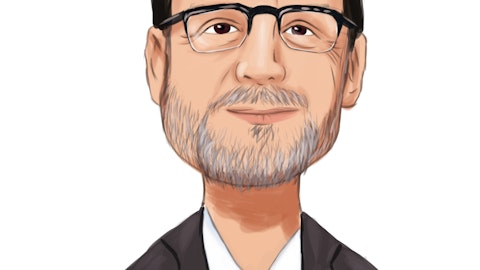Vickie Judy: Yes, certainly. So the frequency of losses was the biggest contributor. The severity was a smaller piece of that. As we talked about before, our consumers, we believe are still pretty healthy. The job markets are still good. Wages are still up. Ours are still up in terms of what they’re working. There is some adjustment here to this inflationary environment and a higher car payment than maybe what they’ve historically been used to. But as you mentioned, overall, things are pretty positive. We feel good about it. We’ve been working with consumers for 40 years. We’re used to working through situations like this with them and that’s what we’ll be focused on.
Jeff Williams: And our customer base has seen some very nice wage increases over the last year and the shortage of workers in those categories that most of our customers work in. So a good wage base there and increasing wages is offsetting a lot of this inflation but it’s still pretty tight from a consumer standpoint.
Kyle Joseph: Got it. Very helpful. And then it was nice to see a good volume recovery, particularly in terms of units there. Is that a function of — I know you mentioned that credit is getting a little tighter in the subprime auto finance world. Is that kind of a function of your consumer getting priced out being by higher rates and being able to shop at kind of franchise or larger dealerships? Or is that a function of the consumer just being a little bit more bargain savvy and preferring kind of the inventory you guys have?
Jeff Williams: I think it’s probably a little both. I think the competition is tightening. Some of the smaller competitors are holding trouble with funding their businesses. So — and then plus our product offering is attractive. So I think it’s a combination of all those factors.
Kyle Joseph: I got it. And then just one last one from me. We track Manheim and obviously, your margins were under pressure in the quarter. I think from your commentary that was more higher procurement costs rather than ongoing increases in used car prices? And just how quickly or would used car prices coming — starting to come down year-over-year and sequentially as well kind of support that gross profit margin even if we have elevated procurement costs?
Jeff Williams: Well, we’ve seen a decrease in the last several months since the beginning of the summer in wholesale prices. Now we are getting closer to tax time now. So that’s levelled off in the availability for the specific car, we’re trying to supply. It doesn’t always follow those same depreciation curve. So we’re thinking that we’re going to see some levelling off and some decreases in prices over the next several months and maybe see some deflation over a longer period of time. But — anything to add to that, Doug?
Doug Campbell: Yes. Well, listen, I’ll sort of — the Manheim Index is incredibly valuable to track. I’ve sort of looked at the time period and locked in January 1 and sort of restated that index from January 1, 2020, prices went up, I’d call it, probably close to 40% on the cohort of vehicles, we really stay focused on sort of reaching a crescendo there in December of last year. They’ve come down about 17% since that point and we expect that to sort of level off throughout the balance of the user as things sort of into the spring market and there’s a little bit more robustness around there. But we could see a more normalized depreciation going forward which we’ll capitalize on. So I think the very first question around the pricing of the vehicles.





